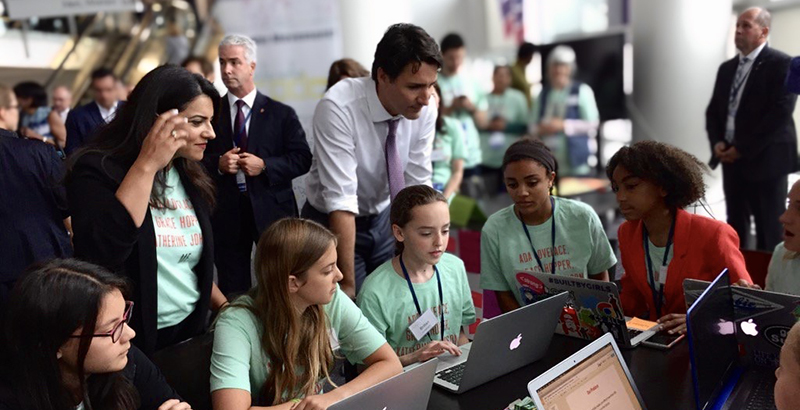Dear Adult Leaders: We’re Still Teaching Like We’re Training 19th Century Factory Workers. Think Beyond Classroom Walls to Nurture Innovators and Thinkers

This piece is part of “Dear Adult Leaders: Listen to Youth,” a four-week series produced in collaboration with America’s Promise Alliance to elevate student voices in the national conversation as schools and districts navigate how to educate our country’s youth in a global pandemic. In this series, students write open letters to adult leaders and policymakers about their experiences and how, from their perspectives, the American education system should adapt. Read all the pieces in this series as they are published here. Read our other coverage of issues affecting young people here. This week’s letters focus on the issue of providing meaningful learning in a COVID-19 environment.
Dear state and district education leaders,
The COVID-19 pandemic has exposed the American education system’s defeat that has been ignored for years. In the media, this failure is simplified, defined only by student outcomes. The United States education system is chasing its tail. Distance learning is challenging, but not the problem. Young people are the victims of years of costly mistakes by adults, followed by a vicious cycle of blame and resistance to adaptation. Everyone agrees we must do better. But how?
As an accidental homeschooler many years ago, my viewpoint is radical and extends beyond the four walls of a classroom. How I see it, distance learning has simply put the existing problems of public education under a microscope. Behavioral psychology tells us that inspiration is the product of helping others, learning a new skill, problem-solving and exploration. In other words, the antithesis of most students’ schooling experiences today especially via Zoom.
John Taylor Gatto, a former New York City teacher of the year and outspoken education critic, reminds us of our antiquated system, “Schools are intended to produce… formulaic human beings whose behavior can be predicted and controlled.” But times are different now. To compete in the 21st century, we need critical thinkers and innovators. We need to stop training 19th century factory workers.
I left brick and mortar school in 2013 looking for an education beyond the traditional classroom. The best way to provide meaningful learning during COVID-19 is to bring the world to the classroom. Here are some ways schools can do this:
1. Connect topics across multiple subjects. Show students how what they’re learning connects to the real world. For example, why not teach how to build a business using math, microeconomics, and computer science?
2. Bring the curriculum to life. In foreign language classes, for example, incorporate cooking and music — core components of culture and thus vital to a fuller understanding of language. Engage students that are native speakers to teach and share with others.
3. Encourage students to buy in and take ownership of their education. Turn schools into mini-cities, complete with leadership and employment opportunities — students could, for example, work in the cafeteria, school store or in other positions where outside vendors are used.
4. Like many universities and businesses, provide on-site childcare for employees in middle and high schools. This would help attract strong teachers who might otherwise struggle to pay for childcare while providing volunteer work and job skills for students.
5. During distance learning, foster relationships and mentorship between students by connecting older students with younger students throughout the school day. Mentorship is a powerful way to learn.
6. Transform cafeterias into cafes, providing culinary arts and hospitality training for students. Brainstorm ideas for a new local business during COVID-19 — like how to transition from in-person retail to something entirely virtual — or launch a fundraiser to save a small business in the community.
7. Teach tolerance by inviting intergenerational community members to collaborate with students on projects or teach a class. For example, the chess or math club could practice and learn from older adults by connecting with the local senior center via Zoom.
8. Allow students interested in the trades to shadow and assist the maintenance staff and landscaping crew. Offer a live feed of actual workers problem solving, offering a teaching opportunity while honoring community members that have not received as much attention like janitorial and facilities staff.
9. Like universities, create work-study programs. This would provide opportunities for students who would otherwise miss school because they are supporting their families.
10. Decrease the digital divide and boost computer science skills by providing students with laptops and other devices. Put the greatest tech minds to work, hiring experts to design programs to enhance education, training teachers, and assisting students.
Look to what works in the business world, universities, and across the globe and allow our future business leaders, mothers, fathers, and community members to develop and access the skills they will need in the 21st century.
Inspire more, require less.
Brittan Gallo, 16
Online High School
Providence, Rhode Island
This series highlighting the perspectives of American youth is in part sponsored by Pure Edge, Inc., a foundation that equips educators and learners with strategies for combating stress and developing social, emotional and academic competencies.
Get stories like these delivered straight to your inbox. Sign up for The 74 Newsletter

;)
